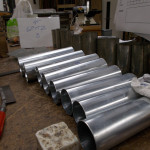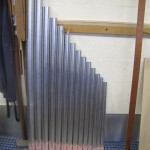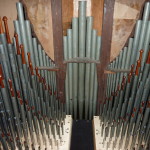This glossary has been produced to help those interested in organs but not familiar with the organ terminology.  If you have any queries or words you’ve heard before but find that they aren’t listed below, then please send us an email and let us know and we’ll add it to our list.
 ACTION:  An action may be mechanical, pneumatic, or electrical (or some combination of these, such as electro-pneumatic action). An organ contains two actions, or systems of moving parts. When a key is depressed, the key action admits wind into a pipe. The stop action allows the organist to control which ranks are engaged.   An electrical connection which, when charged, it magnetizes a piece of metal. This circuit is involved in the mechanism which opens the valves to allow pipes to speak ACTION:  An action may be mechanical, pneumatic, or electrical (or some combination of these, such as electro-pneumatic action). An organ contains two actions, or systems of moving parts. When a key is depressed, the key action admits wind into a pipe. The stop action allows the organist to control which ranks are engaged.   An electrical connection which, when charged, it magnetizes a piece of metal. This circuit is involved in the mechanism which opens the valves to allow pipes to speak |
 BASSES: The largest pipes in the organ. The bottom notes of a given stop. BASSES: The largest pipes in the organ. The bottom notes of a given stop. |
 BELLOWS: Before electricity, bellows were used to supply air. It was made of two wedge shaped pieces of wood joined by an expandable, fan-like piece of leather. Closing the bellows forced air into the Reservoir. BELLOWS: Before electricity, bellows were used to supply air. It was made of two wedge shaped pieces of wood joined by an expandable, fan-like piece of leather. Closing the bellows forced air into the Reservoir. |
 BLOWER: In organs of the twentieth century, a rotary fan for producing organ wind, usually driven by an electric motor. The wind supplied is stored in one or more regulators to maintain a constant pressure in the windchests until the action allows it to flow into the pipes BLOWER: In organs of the twentieth century, a rotary fan for producing organ wind, usually driven by an electric motor. The wind supplied is stored in one or more regulators to maintain a constant pressure in the windchests until the action allows it to flow into the pipes |
 BODY: The upper part of a flue pipe, measured upward from the mouth to the end of the pipe. A pipe body may be either open, closed or partially closed. BODY: The upper part of a flue pipe, measured upward from the mouth to the end of the pipe. A pipe body may be either open, closed or partially closed. |
 BOOT: The lower part of a reed pipe, containing the sound-producing mechanism: shallot and tongue. BOOT: The lower part of a reed pipe, containing the sound-producing mechanism: shallot and tongue. |
 BOXES: Usually refers to a swell box. See Swell shutters. BOXES: Usually refers to a swell box. See Swell shutters. |
 BUILDING FRAME: The structure upon which the organ components are set. Usually constructed of wood, jointed and bolted together. BUILDING FRAME: The structure upon which the organ components are set. Usually constructed of wood, jointed and bolted together. |
 CASE: An enclosure for chests and pipes, usually free-standing. Often decorated and an important part of the acoustical and visual aspect of many organs. CASE: An enclosure for chests and pipes, usually free-standing. Often decorated and an important part of the acoustical and visual aspect of many organs. |
 CELESTE: A rank of pipes similar in scale and voicing to another rank on the same chest, intentionally tuned either sharp or flat in comparison to the unison rank. The effect when the two ranks are played together is a gentle undulation in the pitch. CELESTE: A rank of pipes similar in scale and voicing to another rank on the same chest, intentionally tuned either sharp or flat in comparison to the unison rank. The effect when the two ranks are played together is a gentle undulation in the pitch. |
| CIRCUIT: An electrical connection, when charged, magnetizes a piece of metal. The circuit is part of the mechanism which opens the valves to allow pipes to speak. |
   CHEST: See Windchest   CHEST: See Windchest |
 CHOIR: 1. Usually the lowest manual of the organ console. A corruption of “chair”, referring to a division placed behind the organ bench. Equivalent to the German “Rückpositiv” 2. An enclosed division containing stops useful for accompanying a choir of voices. CHOIR: 1. Usually the lowest manual of the organ console. A corruption of “chair”, referring to a division placed behind the organ bench. Equivalent to the German “Rückpositiv” 2. An enclosed division containing stops useful for accompanying a choir of voices. |
| COMPASS: The range of a keyboard, referring to the normal pitch of the keys themselves, not of the actual sounding pitch of a specific stop. Thus, in normal usage, “compass” refers to the keys, “range” to the pitches played by those keys. |
 CONSOLE: The console consists of a cabinet containing the manual and pedal keyboards and the stop control. The console is either built into the organ case or detached from it and there is a bench for the organist to sit.  Parts of the organ action are found in the cabinet. CONSOLE: The console consists of a cabinet containing the manual and pedal keyboards and the stop control. The console is either built into the organ case or detached from it and there is a bench for the organist to sit.  Parts of the organ action are found in the cabinet. |
 COUPLER:Â Â A coupler allows the stops of one division to be played from the keyboard of another division. COUPLER:Â Â A coupler allows the stops of one division to be played from the keyboard of another division. |